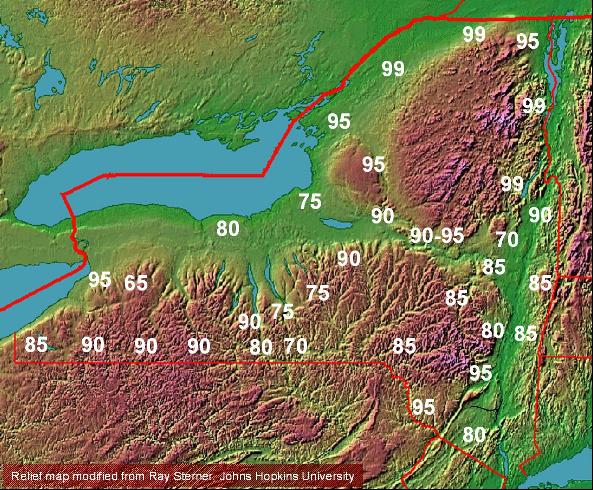Species Selection (Grass, Alternative grasses , Alfalfa-grass)
Grass
In the Northeast, grass species selection is strongly influenced by soil conditions. Selecting forage species that are best suited to a particular soil type and forage use provides the most efficient land use. In NY species are recommended using a web-based program based on potential yield, intended forage use, and soil type (www.forages.org). The number of grass varieties available has increased dramatically in the past few years. An effective method is needed to compare these varieties for both yield and quality. Currently for grass variety trials, all entries in a trial are harvested on the same day, regardless of maturity, or an attempt is made to harvest entries at a similar maturity stage. It is difficult to make varietal comparisons using either of these methods. Same-day harvesting of varieties is biased by plant maturity differences. Harvesting on different days to correct for plant maturity is biased by the environmental conditions preceding each harvest date. Normally forage NDF increases steadily in the spring, but it is possible for forage NDF to temporarily drop as much as 5 percentage units due to a stretch of cold weather. Harvest on different days cannot take weather shifts into account. Adjusting yield and quality for maturity (e.g. heading date) is not satisfactory, as the relationship between heading date and both yield and quality for a set of varieties is relatively poor.
We are proposing a method to compare yield and digestibility of entries in the spring cut on the same day by adjusting yield and digestibility to the same NDF level. This can be accomplished by determining the linear rate of change of yield and quality over time. While rates of change vary slightly among varieties, an average rate of change over time for yield or quality adequately represents all varieties in a trial. Ranking grass varieties for milk/acre is virtually identical to ranking them for dry matter yield/acre. Our system places more emphasis on quality and results in significantly different varietal rankings, compared to unadjusted yield and digestibility. The single best quality comparison under this system is to compare fiber digestibilities adjusted to a common neutral detergent fiber (NDF). The best comparison to combine yield and quality into one term is to rank dry matter yields of varieties that are adjusted to a common NDF.
Alternative grasses for silage
Among grasses, tall fescue has had one of the worst reputations, particularly if being considered as lactating dairy cow forage. Old tall fescue varieties contain an endophytic fungus that makes the plants healthier and stronger, but makes the forage unpalatable for dairy cows. New endophyte-free tall fescue varieties do not have these palatability problems.
Tall fescue’s strengths include the following:
• Tall fescue often ranks highest for yield among cool-season grass species in the Northeast and the Midwest. Tall fescue has yielded up to 20% higher than the most popular perennial grasses grown in New York.
• The top tall fescue varieties yielded over 16 tons (65% moisture) silage per acre in New York State in 2003 on a well-drained loam soil, and yielded over 18 tons silage equivalent in 2004.
• Tall fescue has survived northern New York winters over the past decade and does not appear to have persistence problems in New York or Pennsylvania. Tall fescue may be less persistent than other grasses in the upper Midwest.
From a forage quality standpoint, tall fescue is similar in fiber concentration and digestibility to other grasses when compared at similar growth stages. Tall fescue is typically lower in crude protein than other grasses, except for timothy. Just as the endophyte stigma of tall fescue has started to fade, a new type of endophyte has been introduced. Because endophyte-free tall fescue varieties suffer from reduced persistence compared to the older fescue types in the central United States and in some countries overseas, breeders developed a “novel-endophyte.” Several new varieties contain this less toxic endophytic fungus that will improve plant health and persistence. These varieties do not exhibit the strongly negative affects on palatability and performance that older endophyte-infected varieties do. There have not been persistence problems with adapted endophyte-free tall fescue in the Northeast, however, so the addition of a friendly-endophyte may be of limited value in this region.
Many new tall fescue varieties are available and adapted to much of the northern USA. We currently have field trials at several locations in New York to evaluate tall fescue varieties. In 2005 there was no difference in yield or persistence between four pairs of novel endophyte/endophyte-free varieties at three locations. Tall fescue, which is relatively easy to establish, is well suited to either hay/silage production or pasture systems. Intensive management is required for high silage yields in the 50% NDF range.
Alfalfa-grass

Figure 1. Percentage of alfalfa acreage across New York State that is seeded as mixtures of alfalfa and grass (2005 estimates from county extension educators).
Over 80% of alfalfa sown in New York State is sown with a grass companion crop (Fig. 1). This differs greatly from the Midwest where approximately 20% of alfalfa is sown with grass, and from the West, where very little alfalfa is sown with grass. Roundup-Ready (RR)-alfalfa has the potential to significantly reduce the current acreage of mixed seedings of alfalfa and perennial grass in the Midwest and the West. The impact of RR-alfalfa in the Northeast is less clear. RR-alfalfa sown on a marginal site for alfalfa may only result in a clean, thin stand of alfalfa with unsatisfactory yield. Alfalfa cannot spread from existing plants or reseed itself to fill in wet spots, nor can it fill in stands thinned
by winter damage. RR-alfalfa is less likely to take over the market in the Northeast, as happened with RR-soybeans. It is more likely that the majority of alfalfa stands in the Northeast will remain as mixed seedings.
Top
|